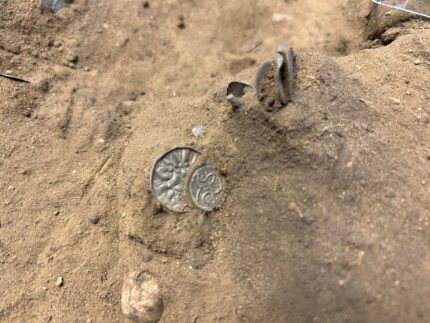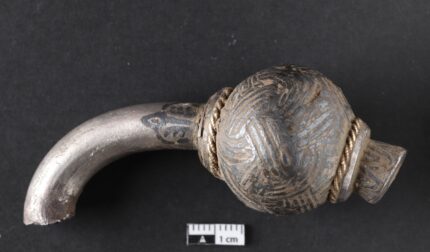 Two hoards of Viking hacksilver and coins dating to the late 10th century have been unearthed under a cornfield near Bramslev in northern Jutland. The two treasures were discovered less than 165 feet apart and are very similar in content. They were originally even closer, but later agricultural activity disturbed the deposits, intermingling the coins and other silver objects.
Two hoards of Viking hacksilver and coins dating to the late 10th century have been unearthed under a cornfield near Bramslev in northern Jutland. The two treasures were discovered less than 165 feet apart and are very similar in content. They were originally even closer, but later agricultural activity disturbed the deposits, intermingling the coins and other silver objects.
The first pieces were discovered last fall by Jane Foged-Mønster, a member of a local metal detecting association, Nordjysk Detektorforening, during a rally on a farmed field. She spotted a piece of silver which turned out to be a clipped Arabic dirham coin, then another fragment, this time a decorated silver ball from a ring buckle. The group, which works closely with museum archaeologists, recognized this was a treasure find and alerted experts from the North Jutland Museum.
Archaeologists followed up quickly with a rescue excavation of the site. Because it was actively in use for agriculture, anything else that might have been part of the hoard remaining in the plow layer was at imminent risk of being scattered or even destroyed. Jane Foged-Mønster and two of her co-discoverers from the metal detecting group aided in the excavation.
 The archaeological team and volunteers spent a week digging at the site. They unearthed 300 finds, from small clippings of silver to jewelry and coins. The decorated ball terminal on a silver rod that Jane Foged-Mønster found has a pair. They both weigh about 70 grams (2.5 oz) and originally were part of the same piece of jewelry, likely a very large ring brooch. This type of jewel was worn by high-status men of Viking Ireland. Something this large and heavy and ornately decorated would have belonged to someone at the highest echelons of society like a bishop or even a king. It was likely looted by Danes in a raid and cut up for its silver weight.
The archaeological team and volunteers spent a week digging at the site. They unearthed 300 finds, from small clippings of silver to jewelry and coins. The decorated ball terminal on a silver rod that Jane Foged-Mønster found has a pair. They both weigh about 70 grams (2.5 oz) and originally were part of the same piece of jewelry, likely a very large ring brooch. This type of jewel was worn by high-status men of Viking Ireland. Something this large and heavy and ornately decorated would have belonged to someone at the highest echelons of society like a bishop or even a king. It was likely looted by Danes in a raid and cut up for its silver weight.
Among the 300 finds are 50 coins, most of them Danish, but also German and Arabic. Some of the Danish coins are extremely rare cross coins struck in the reign of Harald “Bluetooth” Blåtand in the 970s and 980s. The crosses on the coins are believed to be connected to his King Harald’s conversion to Christianity and his aim of Christianizing the Danes. The ring fort of Fyrkat, built by King Harald Bluetooth around the same time the coins were struck, is just five miles away from the hoard site.
Fyrkat, together with Harald Blåtand’s other ring castles, were only in use for a very short time around the year 980. It is unknown why the ring castles were closed down, but at Trelleborg on Zealand, traces of battles have been found.
“Perhaps the castles were not given up entirely voluntarily, and perhaps it happened in connection with the final showdown between Harald Blåtand and his son Svend Tveskæg. The Bramslev treasures were apparently buried around the same time or shortly after the castles were abandoned, and if there have been disturbances at Fyrkat, it makes good sense that the local magnate here at Bramslev has chosen to hide his valuables out of the way, ” says [North Jutland Museums archaeologist] Torben Trier Christiansen.
The site is still harboring archaeological treasure. The excavation found signs of habitation beneath the plow layer. North Jutland Museums has received a grant to return to the site and investigate those structures this fall. The hoard will be exhibited to the public in North Jutland this summer and then transferred to the National Museum in Copenhagen.
In the wake of Otto I’s death, Harald attacked Saxony in 973, and Otto II counter-attacked Harald in 974, conquering Haithabu, “Dannevirke” and (large) parts of Jutland.
Those “ring castles” may have been erected preemptively against the Saxons. After the “Danevirke” had been in place for ages, the 11th century ‘Gesta Hammaburgensis’ do claim that:
——–
…Illi vero bellare moliti, apud Heidibam legatos Ottonis cum marchione trucidarunt, omnem Saxonum coloniam funditus extinguentes. Ad quam rem ulciscendam rex cum exercitu statim invasit Daniam; transgressusque terminos Danorum, apud Sliaswig olim positos, ferro et igne vastavit totam regionem usque ad mare novissimum, quod Nortmannos a Danis dirimit et usque praesentem diem a victoria regis Ottinsund dicitur. Cui egredienti Haroldus apud Sliaswig occurrens bellum intulit. In quo utrisque viriliter concertantibus Saxones victoria potiti sunt, Dani victi ad naves cesserunt. Tandemque condicionibus ad pacem inclinatis, Haroldus Ottoni subicitur, et ab eo regnum suscipiens, christianitatem in Dania recipere spopondit….
——–
“The [Danes] that wanted to fight, however, slew near Haithabu Otto’s diplomats plus the Margrave, and erased the whole Saxon colony. For revenge, the king immediatelly invaded Dania with an army; and transgressing the “Danevirke” that was once built near Schleswig, he devastated the entire region to the outer sea that separates the Norwegians from the Danes, and which for the victory of the king is to the present day called ‘Ottinsund’. As he returned, Harald met him near Schleswig and attacked him. In by both sides bravely fought struggles, the Saxons won, and the Danes retreated to their ships. At last inclined to peace negotiations, Harald bowed to Otto, and received from him his realm back, and he promised to receive Christianity in Dania.”